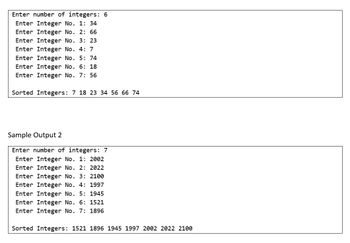
Database System Concepts
7th Edition
ISBN: 9780078022159
Author: Abraham Silberschatz Professor, Henry F. Korth, S. Sudarshan
Publisher: McGraw-Hill Education
expand_more
expand_more
format_list_bulleted
Question
- Write a C++ program that requests any number of input integers from user, sorts and displays the input integers in ascending order using bubble sort
algorithm . Provide a written explanation and output screenshots of your code.
REMINDER:
- Use dynamic memory allocation in C++.
- Do not put all your codes inside main() function. Your sorting algorithm codes must be placed inside a user-defined function.

Transcribed Image Text:Enter number of integers: 6
Enter Integer No. 1: 34
Enter Integer No. 2: 66
Enter Integer No. 3: 23
Enter Integer No. 4: 7
Enter Integer No. 5: 74
Enter Integer No. 6: 18
Enter Integer No. 7: 56
Sorted Integers: 7 18 23 34 56 66 74
Sample Output 2
Enter number of integers: 7
Enter Integer No. 1: 2002
Enter Integer No. 2: 2022
Enter Integer No. 3: 2100
Enter Integer No. 4: 1997
Enter Integer No. 5: 1945
Enter Integer No. 6: 1521
Enter Integer No. 7: 1896
Sorted Integers: 1521 1896 1945 1997 2002 2022 2100
Expert Solution
This question has been solved!
Explore an expertly crafted, step-by-step solution for a thorough understanding of key concepts.
Step by stepSolved in 4 steps with 2 images

Knowledge Booster
Learn more about
Need a deep-dive on the concept behind this application? Look no further. Learn more about this topic, computer-science and related others by exploring similar questions and additional content below.Similar questions
- Write a C function that is given a pointer to memory, the number of bytes of memory the pointer points at, and two pointers to uint32_t. Your job is to treat the pointer as if it were a pointer to an array of uint32_t, find the min and max values of the array, and write the results to the locations pointed at by the uint32_t pointers. The number of bytes will be a positive multiple of 4. Do not worry about endianess in this problem. Note the tester has command line options -Wall -Wextra -Werror -fsanitize=address to help you catch errors.arrow_forwardSolve the problem using C++ (Pattern recognition: consecutive four equal numbers) Rewrite the isConsecutiveFour function in Programming Exercise 8.21 using a vector as follows: bool isConsecutiveFour(const vector < vector < int > > & values) Write a test program like the one in Programming Exercise 8.21. Sample Run 1 Enter row size: 6 Enter column size: 7 0 1 0 3 1 6 1 0 1 6 8 6 0 1 5 6 2 1 8 2 9 6 5 6 1 1 9 1 1 3 6 1 4 0 7 3 3 3 3 4 0 7 The array has consecutive fours Sample Run 2 Enter row size: 6 Enter column size: 7 0 1 0 3 1 6 1 0 1 6 8 6 0 1 5 6 2 1 8 2 9 6 5 6 1 1 9 1 1 3 6 1 4 0 7 5 5 5 3 4 0 7 The array does not have consecutive foursarrow_forwardWrite a C code to order 10 different numbers in descending order. Take input for 10 differentnumbers. Must use pointer type variable. Also, write a user defined function for finding the orderto complete the code.arrow_forward
- Hi! Please help me add this function to my python program. Code given below: 1) Write a function named read_file() that reads the content of a text file (similar to the one generated by the take-input() function in 1.) and store all information in some suitable data structures (e.g., lists, dictionaries, sets, tuples, objects) of your choice. Yes, as the programmer you have the freedom to choose the data structure(s) that you want to use in this section. You can use multiple data structures if you wish. For example, I might want to use a tuple to store the names of the owner and the company as (Bond, Mart 007), and a 2D-list to store the product names/unit prices/stock quantities in this format,[ [prod1,prod2,prod3], [price1,price2,price3], [stock1,stock2,stock3] ].Note, this is just an example and you can choose to store these data using a different format/datastructure. Your function must use exception handling to handle all possible run-time errors sothis function does not crash.…arrow_forwardWrite a C++ program that requests any number of input integers from user, sorts and displays the input integers in descending order using merge sort algorithm. Provide output screenshots of your code. REMINDER: Use dynamic memory allocation in C++. Do not put all your codes inside main() function. Your sorting algorithm codes must be placed inside a user-defined function.arrow_forwardAlert dont submit AI generated answer.arrow_forward
arrow_back_ios
arrow_forward_ios
Recommended textbooks for you
 Database System ConceptsComputer ScienceISBN:9780078022159Author:Abraham Silberschatz Professor, Henry F. Korth, S. SudarshanPublisher:McGraw-Hill Education
Database System ConceptsComputer ScienceISBN:9780078022159Author:Abraham Silberschatz Professor, Henry F. Korth, S. SudarshanPublisher:McGraw-Hill Education Starting Out with Python (4th Edition)Computer ScienceISBN:9780134444321Author:Tony GaddisPublisher:PEARSON
Starting Out with Python (4th Edition)Computer ScienceISBN:9780134444321Author:Tony GaddisPublisher:PEARSON Digital Fundamentals (11th Edition)Computer ScienceISBN:9780132737968Author:Thomas L. FloydPublisher:PEARSON
Digital Fundamentals (11th Edition)Computer ScienceISBN:9780132737968Author:Thomas L. FloydPublisher:PEARSON C How to Program (8th Edition)Computer ScienceISBN:9780133976892Author:Paul J. Deitel, Harvey DeitelPublisher:PEARSON
C How to Program (8th Edition)Computer ScienceISBN:9780133976892Author:Paul J. Deitel, Harvey DeitelPublisher:PEARSON Database Systems: Design, Implementation, & Manag...Computer ScienceISBN:9781337627900Author:Carlos Coronel, Steven MorrisPublisher:Cengage Learning
Database Systems: Design, Implementation, & Manag...Computer ScienceISBN:9781337627900Author:Carlos Coronel, Steven MorrisPublisher:Cengage Learning Programmable Logic ControllersComputer ScienceISBN:9780073373843Author:Frank D. PetruzellaPublisher:McGraw-Hill Education
Programmable Logic ControllersComputer ScienceISBN:9780073373843Author:Frank D. PetruzellaPublisher:McGraw-Hill Education

Database System Concepts
Computer Science
ISBN:9780078022159
Author:Abraham Silberschatz Professor, Henry F. Korth, S. Sudarshan
Publisher:McGraw-Hill Education

Starting Out with Python (4th Edition)
Computer Science
ISBN:9780134444321
Author:Tony Gaddis
Publisher:PEARSON

Digital Fundamentals (11th Edition)
Computer Science
ISBN:9780132737968
Author:Thomas L. Floyd
Publisher:PEARSON

C How to Program (8th Edition)
Computer Science
ISBN:9780133976892
Author:Paul J. Deitel, Harvey Deitel
Publisher:PEARSON

Database Systems: Design, Implementation, & Manag...
Computer Science
ISBN:9781337627900
Author:Carlos Coronel, Steven Morris
Publisher:Cengage Learning

Programmable Logic Controllers
Computer Science
ISBN:9780073373843
Author:Frank D. Petruzella
Publisher:McGraw-Hill Education